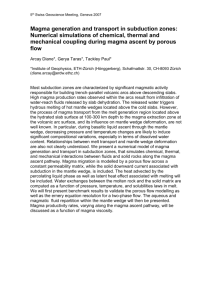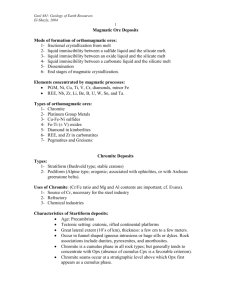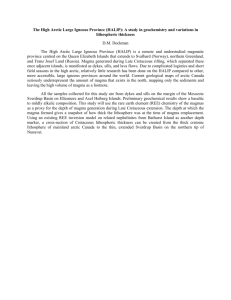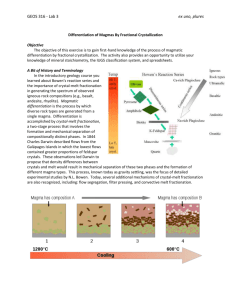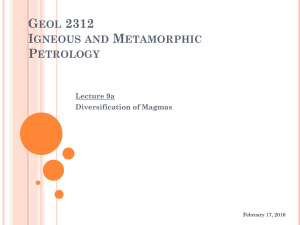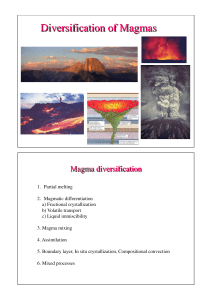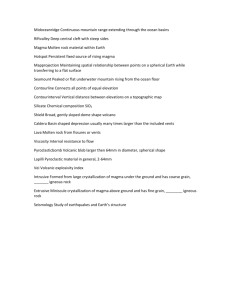Chapter 11
advertisement
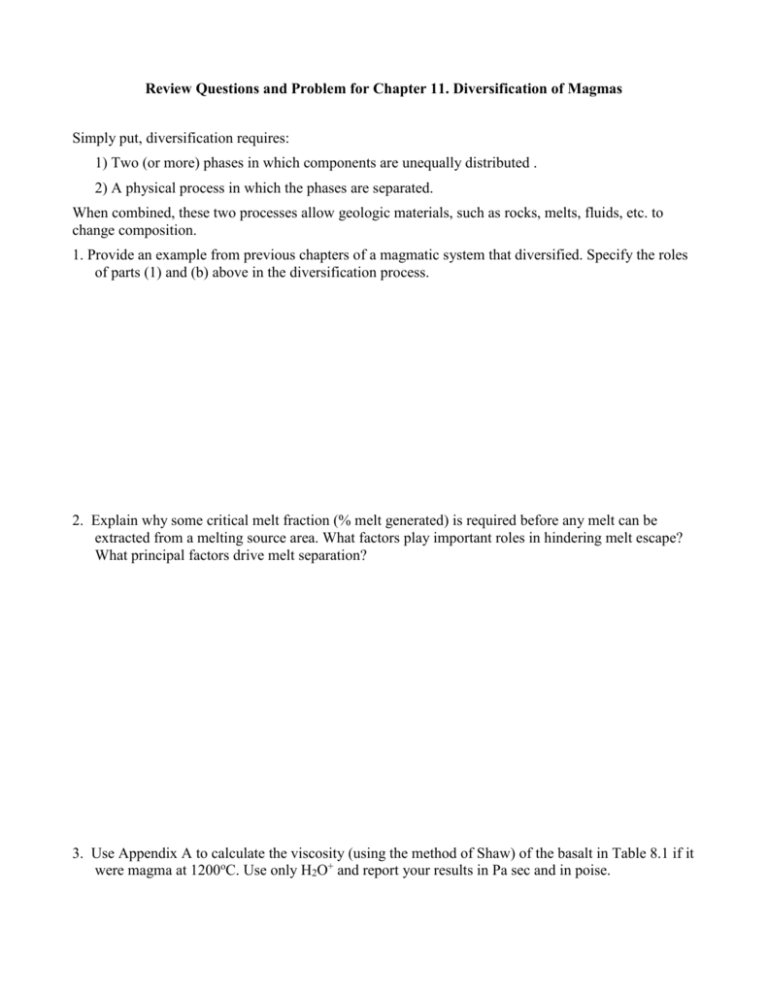
Review Questions and Problem for Chapter 11. Diversification of Magmas Simply put, diversification requires: 1) Two (or more) phases in which components are unequally distributed . 2) A physical process in which the phases are separated. When combined, these two processes allow geologic materials, such as rocks, melts, fluids, etc. to change composition. 1. Provide an example from previous chapters of a magmatic system that diversified. Specify the roles of parts (1) and (b) above in the diversification process. 2. Explain why some critical melt fraction (% melt generated) is required before any melt can be extracted from a melting source area. What factors play important roles in hindering melt escape? What principal factors drive melt separation? 3. Use Appendix A to calculate the viscosity (using the method of Shaw) of the basalt in Table 8.1 if it were magma at 1200oC. Use only H2O+ and report your results in Pa sec and in poise. Gravity settling of early-forming minerals is the classically proposed mechanism for magmatic differentiation. For non-Newtonian fluids, the processes is best described by Stoke’s Law: V 2gr 2 ( s l ) 9 where: V g r s l (Stokes’ Law) (11-1) = the settling velocity (cm/sec) = the acceleration due to gravity (980 cm/sec2 for the Earth) = the radius of a spherical particle (cm) = the density of the solid spherical particle (g/cm3) = the density of the liquid (g/cm3) = the viscosity of the liquid (1 g/cm sec = 1 poise) 4. Calculate the settling velocity of a spherical clinopyroxene with a diameter of 5mm and a density of 3.4 g/cm3 in a basaltic magma with a density of 2.6 g/cm3 and a viscosity of 900 poise. Would gravity settling in such a situation be a conceivably important process? Explain why. 5. What is a Newtonian fluid, and do most silicate melts typically qualify as Newtonian fluids? Why or why not? Which melts are most likely to qualify? Why? 6. What is meant by compaction (filter pressing) when the term is applied to magmatic systems? How does it work, and how might it aid liquid-crystal separation? 7. In Chapter 7 we discussed a method by which a rising H2O-undersaturated magma would reach saturation at shallow levels, and eventually expel an aqueous fluid phase. Briefly describe the process, making it clear why the fluid is released. 8. Retrograde (or resurgent) boiling is the release of an aqueous fluid during the late stages of crystallization of a magma in a magma chamber. Describe how a late magmatic liquid can become H2O-saturated at a constant pressure due to the crystallization process. Again, make it clear why saturation is attained, and why the fluid is released. 9. In either of the two cases in questions 7 and 8, the late stages of rising and crystallizing hydrous magmas typically reach a stage during which a H2O-saturated silicate melt coexists with a silicatesaturated aqueous fluid. Why are veins typically created when this stage is reached? a. Why might porphyritic texture result when H2O is lost from a magma body? In other words, why the sudden increase in nucleation and the growth of many smaller crystals enclosing the alreadyformed phenocrysts? Hint: see Figure 3-1. b. Why do pegmatites typically result from the crystallization of the silicate-saturated aqueous phase (i.e. why the coarse crystals)? c. What is the typical product when the late magma escapes along a vein? d. What other principal type of deposit may be generated at such times? 10. What is meant by liquid immiscibility? When did we encounter the phenomenon before? 11. Apply the criteria (1) and (2) for diversification at the beginning of this handout to a situation of immiscible liquids. 12. Is liquid immiscibility likely to play a major role in the typical derivation of andesites, dacites, and rhyolites/granites from primitive basalts? Why or why not? 13. Describe a reasonable scenario for magma mixing. What would a Harker diagram look like for a series of magmas related by magma mixing of a primitive and an evolved magma? How would such a diagram differ from the Crater Lake Harker diagrams? 14. What is the principal limiting factor for wall-rock assimilation by basaltic melts? What elements would be most readily assimilated, and from what types of wall rocks? Explain. 15. In reference to Figure 11-2 (shown below), describe the processes by which a boundary layer forms. What must be present in order for one to form? 20. What diversification process is most likely to result from an evolved boundary layer? How does such a process create highly evolved liquids in a system that is not largely crystallized? PROBLEM 1. Pick a point on the high-pressure forsterite liquidus in Figure 6.15 (below) and discuss the cooling history in terms of the minerals formed. Next, consider the amount of forsterite that crystallizes if fractional crystallization takes place while the magma rises toward the low-pressure configuration. Demonstrate geometrically why, and in what way, the relative proportion of olivine will be different than in an isobaric situation. Beginning, for example, with an initial bulk composition at 20 wt. % SiO2, use the lever principle to compare the relative proportions of Fo and liquid at 1700ºC and 1.2 GPa and at 1600ºC and 0.1 MPa.




